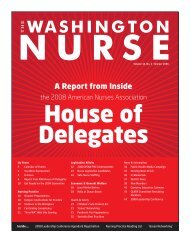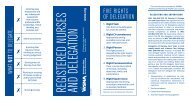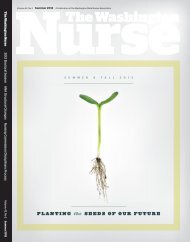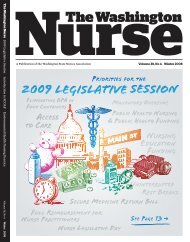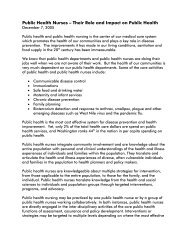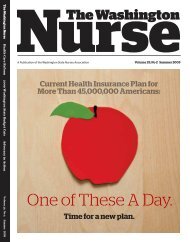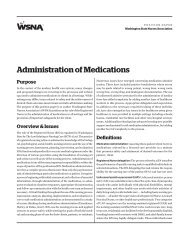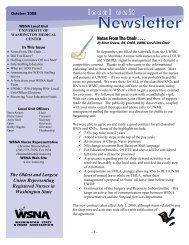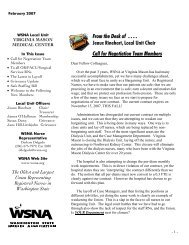Fall 2011 - The Washington State Nurses Association
Fall 2011 - The Washington State Nurses Association
Fall 2011 - The Washington State Nurses Association
You also want an ePaper? Increase the reach of your titles
YUMPU automatically turns print PDFs into web optimized ePapers that Google loves.
Creating Cultures of Safety<br />
Presented by <strong>Nurses</strong> Service Organization<br />
Nursing Practice<br />
Risk management is the process by which vulnerabilities<br />
are identified and changes are made to minimize the consequences<br />
of adverse patient outcomes and liability. Related<br />
clinical initiatives to reduce risk and harm should be part of a<br />
larger organizational commitment to patient safety. In a true<br />
culture of safety, everyone in the organization is committed and<br />
driven to keep patients safe from harm. It’s under the umbrella<br />
of a patient safety culture that risk managers and healthcare<br />
providers effect the most successful clinical change.<br />
Human error is often unavoidable, unpredictable, and unintentional.<br />
Risk managers conduct root cause analyses (RCAs),<br />
which are opportunities for organizational learning and development<br />
of corrective action strategies. However, RCAs are reactive<br />
responses; organizations should also employ proactive risk<br />
assessments for vulnerabilities that can be corrected.<br />
Let’s look at some challenges experienced within large teaching<br />
community hospitals and how they can be addressed. <strong>The</strong> case<br />
examples are hypothetical cases.<br />
Patient identification<br />
Case: It's 9 a.m. <strong>The</strong> transporter arrives to take Mrs. S for a computed<br />
tomography scan with contrast. <strong>The</strong> patient says she’s not supposed<br />
to have any tests, but the transporter insists she’s on the schedule and<br />
the radiology department is busy so they have to hurry. Mrs. S has<br />
the exam. Mrs. J, in the other bed, was actually scheduled for the test.<br />
In almost every case of mistaken patient identification there’s<br />
human error. Factors usually include being in a hurry, not following<br />
policy, language barriers, missing ID bands, staff carelessness,<br />
and patients answering to the wrong name. In the above<br />
case, staff didn’t listen to the patient and there was a lapse in<br />
the patient identification process both at the patient’s bedside<br />
and in the testing area.<br />
Risk management strategies revolve around the basic patient<br />
safety rule of using two patient identifiers to verify identity.<br />
Encouraging patient involvement in combination with active listening<br />
skills of staff is key. Using a second identifier that patients<br />
know, such as their date of birth, facilitates patient participation.<br />
Some organizations have chosen patient identification as a “red<br />
rule,” meaning the two-identifier rule must be followed without<br />
exception or there are defined consequences.<br />
Correct specimen labeling is another vulnerable area in the<br />
patient identification arena. <strong>The</strong> importance of bedside labeling<br />
using two identifiers is vital.<br />
Hospital-acquired infections (HAIs)<br />
Case: Mr. H was brought into the ED unresponsive and hypotensive.<br />
In the ED, a femoral line was placed for emergency access. After<br />
transferring him to the ICU, the femoral line wasn’t changed as per<br />
hospital protocol and CDC recommendations. Approximately 48<br />
hours later the patient became febrile with an elevated white blood<br />
cell count. Blood cultures were positive in 4/4 bottles for enterococcus.<br />
HAIs are often avoidable complications that are in the public eye<br />
and under scrutiny by regulatory agencies, insurance companies,<br />
and malpractice attorneys. <strong>The</strong> bundle checklist has become<br />
a relatively simple yet powerful strategy to standardize practice.<br />
When each critical step is identified, agreed on, observed<br />
at each procedure, and supported by hospital leadership, you<br />
have the recipe for decreasing risk. It works: You can’t forget<br />
important steps when you have a real-time guide to check off<br />
at the procedure. <strong>The</strong> key here is that all concerned follow the<br />
process, communicate with each other, and don’t regard it as an<br />
exercise in postprocedure penmanship.<br />
Enforcement of the golden rule of hand washing is an important<br />
facet on the road to reducing risk from HAI. As with all efforts<br />
to improve safety, best practice must be identified and shared,<br />
along with identifying and fixing barriers.<br />
Communication/escalation<br />
Case: Mrs. F has been in labor for 10 hours. Her electronic fetal<br />
monitoring has started to show absent variability with prolonged<br />
decelerations. Nurse N asks the resident to look at the strips; the resident<br />
recommends the nurse to keep observing. After 10 minutes of<br />
no improvement, Nurse N escalates to the attending physician, who<br />
assures her the baby will be born soon and nothing more needs to<br />
be done. Baby F is born with an Apgar score of 2 and 4, requiring<br />
resuscitation and NICU admission.<br />
In this case the nurse attempts to communicate her concern and<br />
escalates to an attending, but is in a difficult situation: She’s<br />
reached the top of the physician tree, it’s a time-sensitive situation,<br />
and there’s no agreement on case urgency. Several factors<br />
challenge communication and escalation, including fear of disruptive<br />
behavior, cultural/gender perceptions and experiences,<br />
as well as clinical competency and mutual trust and respect.<br />
<strong>The</strong> <strong>Washington</strong> Nurse | <strong>Fall</strong> <strong>2011</strong> | 27



